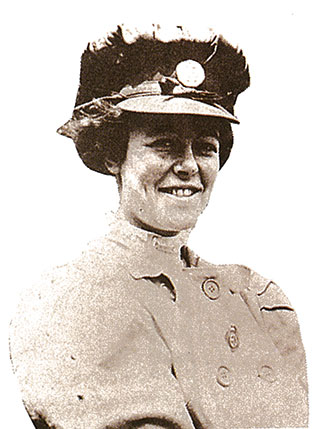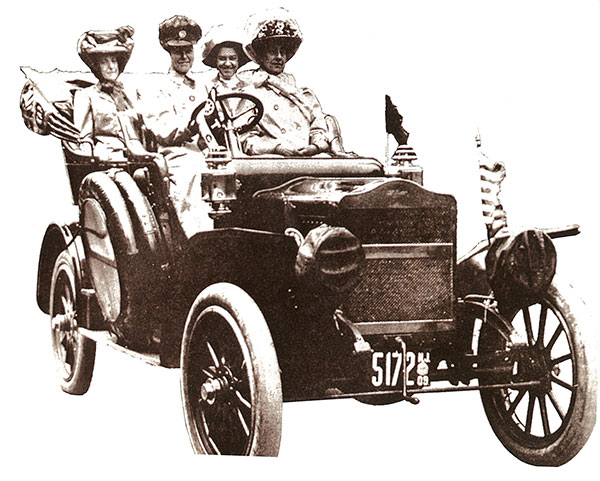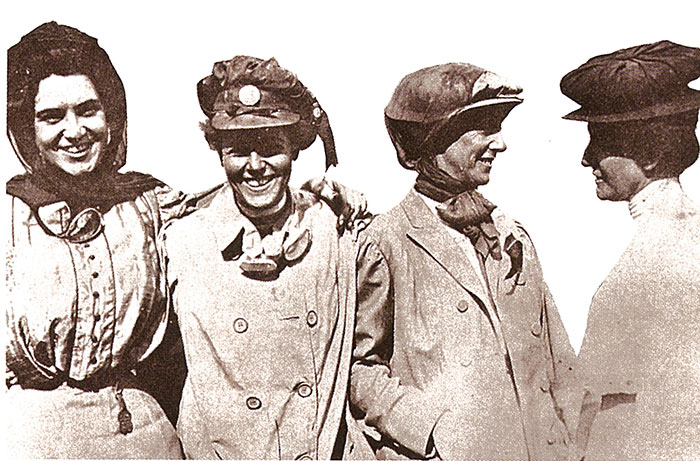Yesterday: Driving Into History
January – February 2020

In 1909 pioneer motorist Alice Ramsey took an automobile, and women drivers, a long way.
BY PHILLIP I. EARL
This story first appeared in the April 1992 issue of Nevada Magazine.
Three quarters of a century ago, women drivers were viewed not only as a danger to themselves and others but also as a threat to society and family life. A few women endeavored to overcome this stereotype, however, among them Alice Huyler Ramsey of Hackensack, New Jersey.
With a green Maxwell automobile as her transport and a brave, pioneering spirit, Ramsey became the first woman to drive across the United States. Her historic travel westward in the summer of 1909 eventually led her to Nevada across present-day U.S. 50 – which not long before had been a route for horses and wagons.
Ramsey’s interest in automobiles first surfaced in high school, where she had taken a shop course and showed a particular talent for fathoming the intricacies of the internal combustion engine. But her love for the automobile began after her husband, attorney John Rathbone Ramsey, bought her a red Maxwell roadster in 1908. She soon became intimately acquainted with dust, grease, mud, flat tires, broken springs, and bad roads that wandered off into nowhere.
The unique idea to send a woman on the New York to San Francisco automobile venture came from a promotion by the Maxwell-Briscoe Motor Car Company.
“Everybody thought I was crazy” she told a reporter for the Nevada State Journal when she returned to Reno in 1974 to retrace the journey. “Making the trip just appealed to me. I was 22 and had a two-year-old son at the time, but my husband was very understanding – he let me go.”
Three other women accompanied Ramsey on the trip – her husband’s sisters, Nettie Powell and Margaret Atwood, and a friend, Hermine Jahns. On June 9, 1909, they drove from Hackensack to the Maxwell showroom in New York City – the official starting point where company officials presented them with a Maxwell 30. The auto was fitted with a 20-gallon fuel tank, a rack for two extra spare tires and extra storage for tubes, a tire repair kit, and a full set of hand tools.
Maxwell dealers along the route were instructed to keep extra tires, gasoline and spare parts on hand to give the travelers every possible assistance
Company officials also hired John I Murphy, automotive editor of the Boston Herald, as advance man to travel ahead by rail to arrange for hotel rooms, receptions and publicity.

Photographers and newsmen held up the start until Ramsey announced that they must be off. “Willing hands reached for the crank handle at the front end,” she later wrote in her book, Veil, Duster and Tire Iron, a recollection of her cross country adventure. “But suddenly, recalling that this was to be a woman’s expedition, I said, ‘Wa-a-it a minute! We’d better get ourselves started.”‘ Giving the crank a twirl, she raced around to retard the throttle. Kissing her husband goodbye, she climbed aboard, shifted into low gear, and roared off down Broadway trailing a banner reading, “From Hell’s Gate to Golden Gate.”
A series of pilot cars and local guides led the expeditioners west, and they added a towing rope, block and tackle, and a shovel to their equipment in Chicago. They encountered torrential rains in Iowa and in western Utah a front axle spring broke, disabling the Maxwell. The three other women decided to take the stage to Ely, but a local blacksmith was able to forge a new spring, and Ramsey and Sam Sharman, who had signed on as a guide in Salt Lake City, continued.
Entering Nevada, the travelers met yet another setback. “Since Ely lay off to our left, we naturally thought the left fork would lead us to our goal,” Ramsey later wrote. “No house to stop and ask and no sign post-also at this point no wires to follow. “But with the aid of maps they finally found Ely late in the afternoon of July 30 and stayed overnight at the Hotel Nevada.
On the way to Eureka they saw a group of Indians on horseback and later learned they were on a rabbit hunt. The following day they got as far as the Walsh ranch east of Austin, where they stopped for the night. Rising early, they breakfasted on a most unusual fare lamb chops and chocolate cake.
Passing through Austin, they encountered some rough going. “We had been told it was an advantage to let some air out of our tires when traveling in heavy sand,” she recalled. “But doing so tore out one of the tire valve stems and gave us more trouble.” After repairing the tire they headed for Reno, but Sharman picked up a man walking in the desert, so they detoured to the camp of Rawhide, 45 miles south of Fallon. “The place had been a very active mining town, but was rather running down even when we were there,” Ramsey wrote.
The run north out of Rawhide the next morning went smoothly, “an 8-mile climb followed by a 7-mile coast. Nice travelling while it lasted!”
Nearing Fallon, their spirits were buoyed by the green farms and ranches of Lahontan Valley. Ramsey said that Fallon was “the prettiest spot encountered in Nevada.”
A crowd gathered when Ramsey pulled up in front of the Hotel Churchill shortly after noon. The women stayed with the car while Sharman looked for a garage to fix some flat tires. A newsman later reported: “The ladies seemed to think that they had quite enough of cross-the-continent autoing and were browned to a point that should satisfy the most exacting. About the only paraphernalia visible was a hat pin, a box of talcum powder, a water bottle, and a ‘little brown jug.’ The latter contained machine oil.”
Leaving for Reno later that afternoon, they drove through Hazen, Fernley and Wadsworth. “But the image which is most vivid in my mind was the unexpected view as we drove over the mountain in the late evening and looked upon the little city of Sparks,” Ramsey later wrote. “I think I shall never forget the surprise of that vista bursting upon us in the darkness. Here was a hollow in which lay a community brilliantly lighted with electricity! Right off the dark and barren desert, this almost bowled us over. It was situated only a couple miles from Reno and was connected by trolley! Surprise! Surprise! Suddenly we had returned to civilization.”

A welcoming party awaited them in Reno. “It was close to midnight when we drew up at the Riverside Hotel,” Ramsey recalled. “But the greetings of the San Francisco and Sacramento Maxwellites, on hand to lead us on our final lap to the Golden Gate, could be heard above the rushing waters of the Truckee River flowing by the side of the building.”
Deciding to cross the Sierra Nevada by way of Lake Tahoe’s south shore, they passed Carson City and headed over the mountains. The Sierra range fronted us with sudden steepness as we started the climb to its crest soon after leaving the capital,” she recalled. “The road was heavy with sand. This was in truth no automobile highway. It was an old wagon trail over the mountains and the grades were stiff. Traffic was largely trucking wagons and powerful horses, mules, or even oxen, and sometimes just men in the saddle.”
Tahoe’s altitude gave the Maxwell’s carburetor fits, and Alice raised the sides on the hood to give the engine more ventilation. The travelers spent the night at Lakeside Park on the lake’s south shore.
They continued on to Stockton and Oakland, arriving in San Francisco on August 7. Loading the Maxwell on the bay ferry, they were welcomed by a large crowd.
Ramsey remained in California for three days and returned home by rail. She gave frequent lectures on her pioneering trip across the country, and in 1960 she wrote Veil, Duster and Tire Iron, recounting her adventures. In 1977 she appeared on Charles Kuralt’s On the Road series. She died at the age of 96 in Covina, California, on September 10, 1983, while plans were under way to mark the 75th anniversary of her historic journey.
Nine years earlier, at the age of 87, Alice Ramsey had returned to Reno for her first visit since the 1909 trip. During an interview at Harrah’s Automobile Collection, she was quick to downplay any notion of women’s lib. Automobile travel was just something she loved, she said, and her husband was more than willing to leave the driving to her.
“He never drove, and he didn’t like to ride in autos,” she said. “He’d go for one ride with me when I got a new car – but he’d always ask “How do you stop this thing?”

